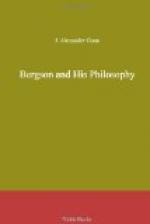The main reason why it is such a difficult matter for us to grasp the reality of continuous change is owing to the limitations of our intellectual nature. “We are made in order to act, as much as and more than in order to think—or, rather, when we follow the bent of our nature, it is in order to act that we think."[Footnote: Creative Evolution, p. 313 (Fr. p. 321).] Intellect is always trying to carve out for itself stable forms because it is primarily fitted for action, and “is characterized by a natural inability to comprehend life” and grasp Change.[Footnote: Creative Evolution, p. 174 (Fr. p. 179).] Our intellect loves the solid and the static, but life itself is not static--it is dynamic. We might say that the intellect takes views across the ever-moving scene, snapshots of reality. It acts like the camera of the cinematograph operator, which is capable only of producing photographs, successive and static, in a series upon a ribbon. To grasp reality, we have to do what the cinematograph does with the film—that is, introduce or rather, re-introduce movement.[Footnote: Creative Evolution, pp. 320- 324 (Fr. pp. 328-332).] The stiff photograph is an abstraction bereft of movement, so, too, our intellectual views of the world and of our own nature are static instead of being dynamic. Human life is not made up of childhood, adolescence, manhood, and old age as “states,” although we tend to speak of it in this way. Life is not a thing, nor the state of a thing—it is a continuous movement or change. The soul itself is a movement, not an entity. In the physical world, light, when examined, proves itself to be a movement. Even physical science, bound, as it would seem, to assert the fixity and rigidity of matter, is now of the opinion that matter is not the solid thing we are apt to think




